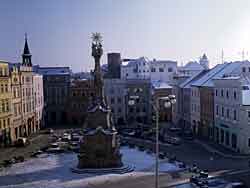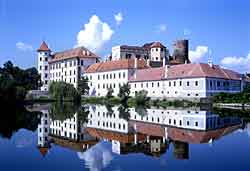JINDRICHUV HRADEC
Southeastern Bohemian has its specific charm. Intersected with creeks, rivers,
and countless lakes over the entire region, the countryside rises from the flatlands
in the west towards the wooded hills known as the Czech Canada, as if wishing
to show off many beautiful phenomena of the nature on a tiny piece of land at
once. Situated amidst all the natural beauty is a genuine gem:
A town overlooks the Vajgar Lake, whose gorgeous panorama of a Gothic castle
and Renaissance chateau are reflected in the water like in a mirror, as though
a silent witness of the bygone glamour of its former aristocratic inhabitants.
A town on the 15th meridian, with the Assumption of Virgin Mary Provost Church
and a massive tower with a view of the entire region.
A town which used to be one of the largest towns in the Kingdom of Bohemia until
the middle of the 17th century.
A town whose historic center has been declared a historical conservation area
for its exquisite historical, architectural, and cultural virtues.
A town sought out by countless tourists, both from home and abroad, for its
unique points of interest and clean environment: a town of the " Golden
Rose " : Jindøichùv Hradec
 |
|
 |
The origins of Jindøichùv Hradec are linked to the existence
of an ancient Slavic fortified settlement on the bend of the Nežárka
River and Hamerský Creek, which became, since at least the 10th century,
a center of administrative and business events, as well as an important strategic
point in the south of the Premyslid domain. Towars the end of the 12th century,
the region of southeastern Bohemia was allotted to Vítek of Prèice,who
divided the territory among his five sons, who thus became founders of important
South-Bohemian aristocratic families known as Vítkovci ( Witigons ):
the Lords of Landštejn, Stráž, Ústí, Rožmberk
( the most powerful ), and Hradec. In their coats-of-arms, each of the Witigons
had a differently colored five-petal rose each.
The earliest mention of Hradec dates to the year 1220, during which time the
estate of Jindøichùv Hradec was owned by the founder of the Lords
of Hradec, Jindøich I, the oldest son of Vítek of Prèice.
It was Jindøich s decision to have a Gothic castle built on the grounds
of the former fortified settlement. Before long, by mid-13th century, the surroundings
of the castle, formarly a small trade and business community, grew to a sizeable
town, which bears his name to this date ( in Latin sources, the town is referred
to as Nova Domus, hence Neuhaus in German sources ).The current name of the
town appeared in historic sources for the first time only in 1410).The coat-of-arms
of the Lords of Hradec, a golden rose on a blue background, eventually supplementted
with two golden lions and letter "W" a special privilege granted by
king Wladislaw II in 1483-these remain in the town s emblem to this day.
In the northeastern corner of the town s historic center is one of the most
remarkable historic treasures of Jindøichùv Hradec, the former
Minorite Cloister and Church of St. John the Baptist and a later-date hospital.
The centrally situated Peace Aquare of Jindøichùv Hradec used
to be dominated by a Gothic Town Hall which has been rebuilt several times (
the first document referring to a repair of a stone town hall dates back to
1493).
The old town s dominant structure is a massive tower of the Assumption of Virgin
Mary Provost Church, situated on the 15th meridian.
The Panská Street connects the center of the old town district with zhe
new town district, ending at the Novomìstské Square ( i.e. New
Town Square - Masaryk Square today ), one side of which opens into the municipal
park, created by filling in the moat that once surrounded the castle and the
old town.




